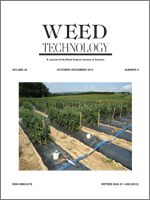Evaluation of turfgrass performance at low nitrogen fertility levels is important because many home lawns are fertilized below common recommendations. The objective of this study was to evaluate visible quality and weed susceptibility of common and alternative cool season grasses under multiple management regimes in Wisconsin. A split-split plot completely randomized block design was used to evaluate ‘Kingfisher' Kentucky bluegrass (Kentucky bluegrass), ‘Kenblue' Kentucky bluegrass, ‘Victory II' chewings fescue, ‘Grande II' tall fescue, and ‘Jiffe II' perennial ryegrass. Each species was mowed at 3.5, 6.0, or 8.5 cm, and fertilized with 0, 98, or 196 kg ha−1 yr−1 of nitrogen. Visible quality and weed cover were evaluated four times annually for 3 yr. Tall fescue had the greatest turf quality across all treatments. Kingfisher Kentucky bluegrass, an improved variety, responded most dramatically to nitrogen fertilization, with quality rating improved from 5.1 to 7.1 when annual nitrogen applications totaled 196 kg ha−1 compared to the nonfertilized control. Kenblue Kentucky bluegrass, a common variety, had the greatest weed cover at all mowing heights and fertilizer rates. Assessment of common dandelion flowers by digital image analysis revealed that improved and common Kentucky bluegrass had greater common dandelion cover than fine or tall fescue when herbicides were withheld for 2.5 yr. Background soil fertility was found to have a significant impact on visible quality and weed cover. In an area with eroded, low-fertility soil, improved Kentucky bluegrass required 196 kg N ha−1 yr−1 to maintain high quality and limit weed invasion. These results suggest that tall fescue is best suited to low and high input conditions, while improved varieties of Kentucky bluegrass performed acceptably only under high inputs.
Nomenclature: Chewings fescue, Festuca rubra var. commutata Gaud FESRU; common dandelion, Taraxacum officinale G.H. Weber ex Wiggers TAROF; Kentucky bluegrass, Poa pratensis L. POAPR; perennial ryegrass, Lolium perenne L. LOLPE; tall fescue, Lolium arundinaceum (Schreb.) S.J. Darbyshire FESAR.
La evaluación del desempeño del césped a niveles de fertilidad bajos en nitrógeno es importante porque los céspedes caseros son fertilizados por debajo de las recomendaciones comunes. El objetivo de este estudio fue evaluar la calidad visual y la susceptibilidad a las malezas de zacates de clima frío comunes y alternativos bajo múltiples regímenes de manejo en Wisconsin. Se usó un diseño de bloques completos al azar en parcelas subdivididas para evaluar Poa pratensis 'Kingfisher' y 'Kenblue', Festuca rubra var. commutata 'Victory II', Lolium arundinaceum 'Grande II' y Lolium perenne 'Jiffe II'. Cada especie fue podada a 3.55, 6.0 ó 8.5 cm, y fertilizada con 0.98 ó 196 kg ha−1 año−1 de nitrógeno. La calidad visual y la cobertura de malezas fueron evaluadas cuatro veces anualmente durante 3 años. L. arundinaceum tuvo la mayor calidad en todos los tratamientos. Kingfisher, una variedad mejorada, respondió más dramáticamente a la fertilización nitrogenada, con una mejora en la evaluación visual al compararse con el testigo sin fertilización de 5.1 a 7.1 cuando las aplicaciones anuales de nitrógeno totalizaron 196 kg ha−1. Kenblue, una variedad común, tuvo la mayor cobertura de malezas en todas las alturas de poda y dosis de fertilización. Evaluaciones de l





